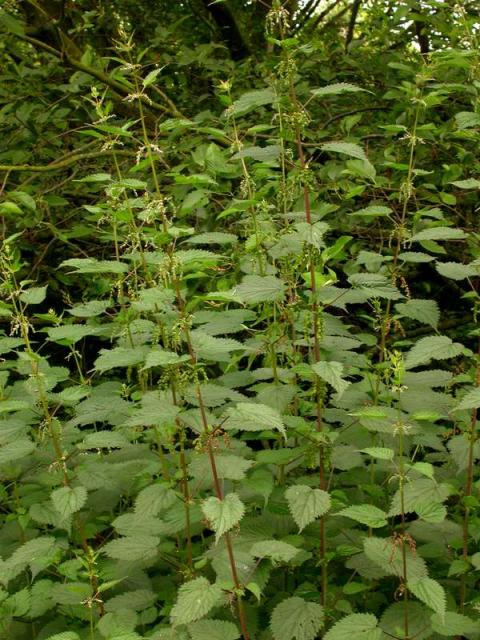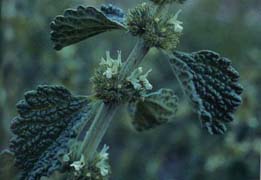Stinging Nettle
Nettle Family
Urticaceae
Latin Name: Urtica dioica
Common Names: Stinging Nettle, Nettle
Native American Names: (none found)
Related Species: Along with the Nettle Family, the order Urticales also contains the Hemp, Mulberry, and Elm Family. In the Nettle Family, only the genera Dendrocnide, Laportea, Obetia, Urera, and Urtica cause contact dermatitis (1:online). Urtica ferox, New Zealand’s tree nettle, is even said to have killed a human (2:online).
Sitting With/Dreams/Sense of the Plant:
(April 19th, 2007, Longhouse Garden Riparian Hillside, late morning, partly cloudy) While drawing this beautifully humble and delicate looking plant, memories came back of my childhood. Our backyard used to reach out into cornfields that are now covered by new development. Every year in spring a stretch of stinging nettles would sprout up between our fence and the crop. I have vague memories of climbing across the fence in my light summer dress and jumping directly into the stinging nettles, which at that time were taller than the little me. Had it not been for my parent’s lectures that stinging nettles are the reason we have beautiful peacock butterflies, I would never have been able to get over my dislike of this plant. I have learned since, that not everything that stings is bad, and while admiring it’s simple presence, I feel that through its sting, it could hold on to grace and dignity amongst human curiosity.
Body System Affiliations:
1. Urinary System
2. Digestive System
2. Reproductive System
3. Musculo-skeletal System
4. Immune System
5. Respiratory System
6. Integumentary System
7. Cardio-vascular System
Botanical Description:
Habit: Herb, Perennial, Monoecious (3:371).
Size: 2-4 meters.
Arrangement: Opposite
Leaves: Ovate, serrate, 2-6” long, 1-2” wide
Flowers: greenish-white, small, clustered, originating from leaf axils
Fruit: small, oval, one-seed bearing, dry fruit from each flower (4:online).
Underground Parts: Extensive rhizomes, some local fibrous roots
Personal Observation and Description: Leaves can have a maroon tint when the plant is still young. While I find the plant easily confused with other plant species such as catnip (Nepata cataria), it can be distinguished by its single, straight, dark, and firm stem, hairs on its neatly opposite arranged leaves, and the height of the mature plant.
Ecology:
Habitat: Moist, rich soil in shade. Usually along streams, riverbeds, or in floodplains (5:186).
Range: Naturalized in most temperate and tropical climate zones.
Native Where: Northern Africa, temperate and tropical zones of Asia, most of Europe and North America (6:online).
Personal Observation
Locations Observed: Disturbed or open areas, moist habitat such as along creeks and by wetlands.
Dates: Multiple. Most recently this spring (2007) at the TESC Longhouse Ethnobotanical Garden.
Description of Plants: Observation of Urtica dioica on different continents made me conclude that once you know what the plant looks like, you will be able to identify it anywhere it grows. The plant is tall and straight once mature. The stem is a dark maroon and the leaves are hairy and thin. The lower on the plant a leaf, the larger and flatter it is.
Western (European-American) Uses/Relationships:
Food: Stinging nettles can be eaten when cooked. They can also be used as a coloring agent, curdling agent, and the cooking liquid used as a drink (7:online).
Materials/Technology: The fiber of nettle stems can be used to make string, cloth, and paper. The leaves and roots of the plant can be used for dye. The whole plant can be used to make insect repellent, fertilizer, compost addition, and for waterproofing wood structures (7:online).
Medicine:
Part Used: Leaves
Medicinal Actions: Tonic, alterative, adaptogen (8:315/6), diuretic, laxative, anti-diabetic, anti-rheumatic, antiseptic, epispastic, pectoral, anti-asthmatic, expectorant, anti-inflammatory (3:371/2), astringent, depurative (5:188/9).
Indications: Edema, arthritis, eczema, psoriasis, bleeding, urinary tract inflammation, sinus allergies, congestion, mucous membrane irritation (5:188/9), hair loss, hypertension, pain, allergies, sluggish digestion, infection, parasites, overweight, excessive menstrual bleeding, diarrhea, ulcers, rheumatism, sciatica, head lice, prostate disease (3:371)
Body System Associations: Urinary, digestive, reproductive, cardio-vascular, musco-skeletal, immune, respiratory, integumentary.
Constituents: Formic acid (only when fresh), galacturonic acid, ascorbic acid, histamine, 5-hydroxytryptamine, choline, acetylcholine, vitamin A, vitamin D, iron, sodium, potassium, phosphorus, calcium, silica, albuminoids (5:186).
Applications: Infusion, capsule, cooked whole.
Preparation: For infusion, boil 1 part dried root with 32 parts water for 10 minutes. Remove from heat, cool, and strain (5:24).
Pharmacy: Infusion: 1 cup, 2-3 times a day. Capsules: 2-3 grams, 2-3 times a day. Externally, apply infusion to skin when needed.
Cautions: People with cardiovascular conditions, electrolyte imbalances, or on diuretic medication should talk to their doctor before using nettles medicinally (3:375/6).
* * *
Part Used: Seeds (5:189)
Medicinal Actions: unknown.
Indications: Dandruff, baldness.
Body System Associations: Integumentary.
Applications: Salve.
Preparation: Moisten dried seeds with alcohol and steep one part herb in 3 parts olive oil for 7 days. Blend, leave to resettle, and filter. Add oil of rosemary or lavender.
Pharmacy: Rub oil into scalp before shampooing as needed.
Cautions: none known.
* * *
Part Used: Roots (3:372-375)
Medicinal Actions: diuretic.
Indications: Benign prostatic hyperplasia, hair loss
Body System Associations: Reproductive, integumentary.
Constituents: Scopoletin, sterols, fatty acids, polysaccharides, isolectins.
Applications: Infusion, tincture, capsules.
Preparation: For infusion, boil 1 part dried root with 32 parts water for 10 minutes. Remove from heat, cool, and strain. For tincture, cover 1 part chopped root with 2 parts pure grain alcohol. Set aside for 7-10 days and strain (5:24-27). For capsule, dry herb thoroughly and insert into a capsule.
Pharmacy: For preventative prostate health, ½ cup root infusion 2-3 times a week. Alternatively, 2-3 ml root tincture or 2-3 g powdered root capsules instead of an infusion. For benign prostatic hyperplasia treatment, use same preparation 2-3 times daily.
Cautions: People with cardiovascular conditions, electrolyte imbalances, or on diuretic medication should talk to their doctor before using nettles medicinally (3:375/6).
Indigenous and Non-Western Use/Significance/Relationships:
Food: Stinging nettle is celebrated by some native american tribes as the first green food of the season. It is usually steamed and served with butter. The steaming liquid is consumed as a tea along with the greens (personal source).
Materials/Technology: none found.
Medicine: none found.
Propagation:
Technique: Seed, cuttings, root divisions (8:82).
Personal Experience: (none).
Harvest:
Plant Part: Entire shoot.
Season of Harvest: Early spring until mid-summer (5:186).
Method of Harvest: Cut shoots right above the root after morning dew has evaporated. Wearing gloves is advised. Placing them upside down in a paper bag can help keep you from getting stung. If not used fresh, dry in loose bunches hanging upside down in an airy location inside (9:online).
Ecological Considerations of Harvest: (none found)
Cultural Considerations of Harvest: (none found)
Cautions: Do not collect stinging nettle along drainage ditches or near agricultural lands (5:186). Watch out for contact dermatitis.
* * *
Plant Part: Seeds
Season of Harvest: Late summer (5:189)
Method of Harvest: Dry seeds in the sun or using a stove (9:online).
Ecological Considerations of Harvest: (none found)
Cultural Considerations of Harvest: (none found)
Cautions: Do not collect stinging nettle along drainage ditches or near agricultural lands (5:186). Watch out for contact dermatitis.
* * *
Plant Part: Roots
Season of Harvest: Fall and Winter (4:online).
Method of Harvest: (none found)
Ecological Considerations of Harvest: (none found)
Cultural Considerations of Harvest: (none found)
Cautions: Do not collect stinging nettle along drainage ditches or near agricultural lands (5:186). Watch out for contact dermatitis.
* * *
Plant Part: Stem (9:online)
Season of Harvest: Starting late spring when plants are mature and stems tall.
Method of Harvest: Same as harvest for entire shoot. Strip leaves after drying.
Ecological Considerations of Harvest: (none found)
Cultural Considerations of Harvest: (none found)
Cautions: Do not collect stinging nettle along drainage ditches or near agricultural lands (5:186). Watch out for contact dermatitis.
Personal Experience:
Food: I tasted steamed/cooked nettle on two ocasions. The first time was on March 12th during class when someone brought in steamed nettles for their final presentation. She explained that in her native tradition nettles are celebrated as the first sign of spring and the first fresh green food of the year. The second time was during the first few weeks of Healing Gardens this quarter.
Part Used: young shoots
Procurement: I did not take part in harvesting the nettles.
Condition: fresh, cooked
Experience: Nettles have a pleasant, sublte, green taste with a touch of sourness.
Materials/Technology: (no experience)
Medicine: (no experience)
Cautions: Nettles sting! Handle with care!
References Cited:
<!--[if !supportLists]-->1. <!--[endif]-->Schmidt, Richard J. The Botanical Dermatology Database. Online at http://bodd.cf.ac.uk/BotDermFolder/BotDermU/URTI.html [1]. Last Updated 4-2007. Visited 4-24-2007.
<!--[if !supportLists]-->2. <!--[endif]-->Author Unknown. Wikipedia. http://en.wikipedia.org/wiki/Nettle [2]. Constantly Updated. Visited 4-23-2007.
<!--[if !supportLists]-->3. <!--[endif]-->Taylor, Leslie. The Healing Power of Rainforest Herbs. Garden City Park, New York: Square One Publishers, 2005.
<!--[if !supportLists]-->4. <!--[endif]-->Author Unknown. Permaculture Information Web. http://www.permaculture.info/index.php/Urtica_dioica [3]. Last Updated 05-01-2007. Visited 05-22-2007.
<!--[if !supportLists]-->5. <!--[endif]-->Moore, Michael. Medicinal Plants of the Pacific West. Santa Fe, New Mexico: Red Crane Books, 1993.
<!--[if !supportLists]-->6. <!--[endif]-->USDA National Genetic Resources Program. Germplasm Resources Information Network. Online at http://www.ars-grin.gov/cgi-bin/npgs/html/taxon.pl?40944 [4]. Last Updated 05-18-2007. Visited 05-18-2007.
<!--[if !supportLists]-->7. <!--[endif]-->Author Unknown. Plants For A Future. Online at http://www.ibiblio.org/pfaf/cgi-bin/arr_html?Urtica+dioica [5]. Last Updated 5-2004. Visited 4-24-2007.
<!--[if !supportLists]-->8. <!--[endif]-->Phillips, Nancy and Michael. The Herbalist’s Way. White River Juction, Vermont: Chelsea Green Publishing Company, 2005.
<!--[if !supportLists]-->9. <!--[endif]-->Grieve, M. A Modern Herbal. Online at http://www.botanical.com/botanical/mgmh/n/nettle03.html [6]. 1931. Visited 05-25-2007.
A. S. - Healing Gardens - Spring - 2007

Image by: A. S.
Plant Location: The Evergreen State College Longhouse Ethnobotanical Garden

Photograph by: Ben Leger
Source: http://biology.burke.washington.edu/herbarium/imagecollection.php?ID=14439 [7]
Date: 2004
